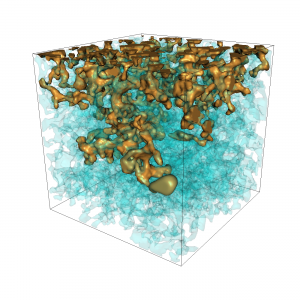Powered by SIMULIA’s best-in-class Lattice-Boltzmann physics, DigitalROCK provides the first reliable, predictive technology for digital pore-scale simulation of relative permeability. The ability to accurately simulate two-phase flow, such as oil and water, through reservoir rock was co-developed and extensively validated with oil and gas industry leaders.
Oil and gas reserves lie buried thousands of feet beneath layers of rock, and extracting them requires understanding how fluids flow through the porous rock. Primary recovery typically extracts only 10 to 30 percent of the available resources, and even secondary recovery tends to leave a large amount of hydrocarbons behind. These can be retrieved with Enhanced Oil Recovery (EOR) methods, which involve injecting a secondary fluid into the rock to displace the oil. A further challenge is introduced through these methods, however, as calculating the behavior of the oil-water mixture is complicated, and performing multi-phase relative permeability tests on samples is a slow and expensive process with poor reproducibility.
DigitalROCK is the first cloud-based solution that allows users to accurately, reliably predict multi-phase flow properties of reservoir rocks. The software enables users to obtain MICP curves, absolute permeability and multi-phase relative permeability in days rather than months. DigitalROCK uses a proprietary, full-physics digital simulation technology to reduce the time and cost associated with testing core samples.
Users of DigitalROCK can analyze more samples faster for better rock property data, resulting in higher confidence. They can reuse digital samples for various scenarios and reduce the uncertainty of reservoir modeling and EOR potential. The SIMULIA Cloud offers a streamlined automated workflow and a permanent database of rock samples and results.
A typical special core analysis laboratory (SCAL) test program can take months or even up to a year to obtain critical relative permeability data. Due to the long wait times and challenges associated with generating reliable SCAL data, very few core samples from a field are typically tested, despite the fact that the reservoir modeling results are critically dependent on them.
Even for single-phase absolute permeability, for which lab testing is relatively fast and routine, the lab results can often be inconsistent or unexpected, requiring a cross-check. In addition, whole core samples are required for reliable lab testing, and extracting this core is time-consuming and expensive. Therefore, it is taken only from certain wells.
With DigitalROCK, however, multi-phase analyses can be run in three to six days, and five to ten analyses can be run in parallel on a large cluster. The computational modeling solution uses a high-resolution 3D image of a rock sample to determine absolute and relative permeability as well as capillary pressure. This virtual lab is much faster, more reproducible and cost-effective than physical testing.
Oil and gas are precious and limited resources, so it is vital to optimize recovery. DigitalROCK allows not only for more thorough resource extraction, it makes the process drastically faster, cheaper and more efficient.
